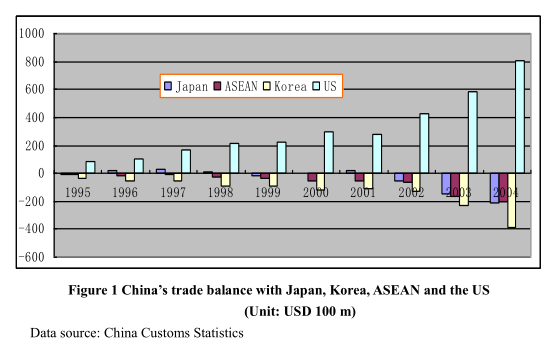Industrial Effect of a China-Japan- Korea FTA: Cross-sector Analysis
Sep 01,2005
Zhang Xiaoji, Zhang Qi, Zhang Liping& Xu Hongqiang
I. New progress in intra-regional trade and investments of China, Japan, and Korea
Over the past year, China, Japan, and Korea all maintained good economic growth, and created a new situation of healthy interaction through bilateral trade and investment.
1. Intra-regional trade
China, Japan, and Korea are all big trading powers. The commodity trade of the three countries contributed 14.2% to the world’s trade in 2003. Trade between China, Japan and Korea maintained rapid growth, at a rate higher than global trade. The intra-regional trade has continuously expanded, up to 24% of the three countries’ total foreign trade in 2003. However, the growth of intra-regional trade was attributed to the rapid increase in the exports of Japan and Korea to China. In other words, the robust intra-regional trade was driven by China’s dramatically expanded domestic demand.Japan and Korea are China’s major export destinations and import sources (See Table 1). In 2003, China’s exports to Japan and Korea ranked the fourth and sixth of all its export destinations. Meanwhile imports from Japan and Korea ranked first and fifth of China’s import sources. China’s foreign trade is more dependent on imports from Japan and Korea than exports to them.

The industrial structures of China, Japan and Korea complement each other. The industries in China with prominent comparative advantages are in the labor-intensive sector. Japan and Korea are more competitive in the capital-intensive and technology-intensive sectors while Japan is more prominent in the sectors such as transportation equipment, precision instruments, chemicals, and machinery and electronic products. Since mid-1990s, the structure of Sino-Japan and Sino-Korea bilateral trade has been upgrading with machinery and electronics became the largest category in bilateral trade in terms of trade value.
2. Bilateral investment
Foreign direct investment (FDI) is crucial to division of labor and industrial layout in Northeast Asia. Among the three countries, Japan is a capital provider, China is a capital receiver, and Korea is a capital receiver from Japan and a provider to China. The intra-regional investment made up 8.4% of the total in the region in 2003, up slightly over the previous year. For China, Japan is its third largest investment source, with a total investment of USD 16.5 billion over the past four years. Korea ranked first among all of China’s investment sources in terms of investment growth rate. Its investment in China amounted to USD 10.6 billion in the past four years. According to Korean statistics, the investment from Japan reached USD 5.16 billion in 2000-2003, accounting for 12.3% of Korea’s total FDI inflow, much higher than only 1.1% from China. Japan was the second largest investment source of Korea. FDI to China from Japan and Korea is a critical determinantfactor for the division of labor and industrial layout in Northeast Asia.
Of all foreign investment in China, 70% is concentrated in the manufacturing sector. Among the investment of Japan and Korea to China, 79% and 87% flowed to the manufacturing sector respectively. The textile and clothing industry used to be favored by investors from Japan and Korea. In recent years, however, Japanese and Korea’s enterprises have been more inclined to invest in electronics and telecommunication equipment, transportation equipment, electric machinery, and general equipment industries. Investments in these fields and its proportion in total manufacturing investment both increased drastically.
3. Relationship between trade and investment
The selection of industry and region for foreign direct investment has a significant impact on the intra-regional trade and trade with other regions. For instance, Japan and Korea conducted industrial transfer to China through FDI. That did not impair their position as strong manufacturing countries, but expanded their exports to China. Meanwhile, foreign-invested enterprises (FIEs) have occupied a share of over 50% in China’s trade with Japan and Korea[1], and Japanese- and Korean FIEs play a dominant role. It is evident that the promotion effect that FDI exerts on China’s bilateral trade with Japan and Korea is much higher than the substitution effect.
FDI also plays a crucial role in maintaining trade balance between within and outside East Asia.
On account of China’s down-stream position in East Asia’s production chain, many countries tend to move more and more goods to China for processing export. Transfer trade has led to increasingly expanded deficits in China’s trade with Japan, Korea and ASEAN (See Figure 1). In contrast, China’s trade surplus with the US is expanding. Transfer trade has become one of the major factors causing trade friction between China and the US.

With a China, Japan and Korea FTA (CJKFTA), some industries in China would lose tariff protection and Chinese products would be at a disadvantage to those made by Japan and Korea in a short term. However, from a dynamic point of view, China has advantages in huge market size, low production costs and high savings ratio, thus making it extremely attractive to overseas investors. Its production capacity is continuously expanding on the strength of domestic and overseas investment (including investment from Japanese and Korean FIEs) with improved industrial structure and technological level. The trade creation effect by removing tariff barrier by China, Japan and Korea may speed up the transfer of intra-regional resources into China, while attracting more external investment into the region. In order to avoid trade diversion effect on countries outside the region, China will take active efforts to promote multilateral trade liberalization and cut down import tariffs on goods from outside. We believe China can share the benefits from regional trade liberalization, and achieve positive results for all economies in the world, taking into account the reciprocally-promoting relationship between trade and investment under globalization as well as China’s economic vitality and dynamic comparative advantages.
…
If you need the full text, please leave a message on the website.
--------------------------------------------------------------------------------
[1]Under the processing trade, FIEs contribute up to 77% of China’s trade with Japan and South Korea.














